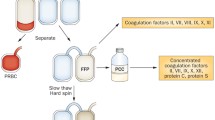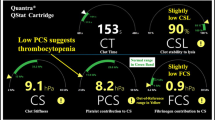Abstract
Objectives Percutaneous liver biopsies are used to grade and stage liver disease and are also useful in monitoring the progress of liver disease over time as well as the response to medical therapies. The present study was undertaken to assess the effectiveness of recombinant factor VIIa as a means of transiently correcting the coagulopathy, enabling the safe performance of a percutaneous liver biopsy in patients in whom the use of fresh-frozen plasma is not possible without precipitating pulmonary edema or who have a treatment induced (iatrogenic) coagulopathy. Methods The subjects of this report consisted of 18 consecutive individuals with advanced disease induced, and 15 with a therapeutic iatrogenic-induced, coagulopathy. All biopsies were performed by a single hepatologist. Before and 6 h after each biopsy, a prothrombin time and partial thromboplastin time was obtained from each subject. Mean values ± the standard error of the mean were obtained using the independent samples T-test. Results Recombinant factor VIIa had a marked effect in transiently correcting the mean prothrombin time in these subjects allowing for a safe complication free percutaneous biopsy in this high-risk group. Conclusions Recombinant factor VIIa could be used to obtain a clinically indicated liver biopsy in severely ill patients, who without this therapeutic agent, would either not be biopsied or, if biopsied, would require much longer hospitalization and the use of fresh-frozen plasma (with its risks of volume overload and infection).
Similar content being viewed by others
References
Spycher C, Zimmermann A, Reichen J. The diagnostic value of liver biopsy. BMC Gastroenterol. 2001;1:12. doi:10.1186/1471-230X-1-12.
Stuart KL, Bras G, Patrick SJ, et al. Further clinical and investigative uses of liver biopsy; an analysis of five hundred-twenty-seven biopsies. Arch Intern Med. 1958;101(1):67–83.
Ishak K, Baptista A, Bianchi L, et al. Histological grading and staging of chronic hepatitis. J Hepatol. 1995;22(6):696–699. doi:10.1016/0168-8278(95)80226-6.
Franciscus A. Grading and staging a liver biopsy. Information from Hepatitis C Support Project (HCSP); 2006.
Gondal R. Evaluating liver disease in chronic viral hepatitis: indication and role of liver biopsy. J Gastroenterol Hepatol. 2004;19:S338–S341. doi:10.1111/j.1440-1746.2004.03698.x.
Ansell ID. The uses of liver biopsy. Postgrad Med J. 1969;45(521):202–207. doi:10.1136/pgmj.45.521.202.
Bravo AA, Sheth SG, Chopra S. Liver Biopsy. N Engl J Med. 2001;344:495–500. doi:10.1056/NEJM200102153440706.
Lebrec D. Various approaches to obtaining liver tissue—choosing the biopsy technique. J Hepatol. 1996;25(1):20–24. doi:10.1016/S0168-8278(96)80065-1.
Fresh frozen plasma. Indications and risks. NIH Consensus Development Conference Statement 1984; 5(5):1–12.
Youssef WI, Salazar F, Dasarathy S, et al. Role of fresh-frozen plasma infusion in correction of coagulopathy of chronic liver disease: a dual phase study. Am J Gastroenterol. 2003;98:1391–1394. doi:10.1111/j.1572-0241.2003.07467.x.
O’Shaughnessy DF, Atterbury C, Bolton Maggs P, et al. Guidelines for the use of fresh-frozen plasma, cryoprecipitate and cryosupernatant. Br J Haematol. 2004;126(1):11–28.
Bedossa P, Poynard T. An algorithm for the grading of activity in chronic hepatitis C. The METAVIR Cooperative Study Group. Hepatology. 1996;24(2):289–293.
Kositchaiwat C, Chuansumrit A. Experiences with recombinant factor VIIa for the prevention of bleeding in patients with chronic liver disease undergoing percutaneous liver biopsies and endoscopic retrograde cholangiopancreatography (ERCP). Thromb Haemost. 2001;86(4):1125–1126.
Al Sobhi A. Successful outcome of using recombinant activated factor VII (rFVIIa) in liver biopsy in a patient with liver failure. J Thromb Haemost. 2006;4((9):2073–2074.
Jaffers L, Chalasani N, Balart L, et al. Safety and efficacy of recombinant factor VIIa in patients with liver disease undergoing laproscopic liver biopsy. Gastroenterology. 2002;123(1):118–126.
Carvalho A, Leitao J, Louro E, et al. Small dose of recombinant factor VIIa (rFVIIa) to perform percutaneous liver biopsies in cirrhotic patients. Rev Esp Enferm Dig. 2002;94(5):280–285.
Bernstein D. Effectiveness of the recombinant factor VIIa in patients with the coagulopathy of advanced Child’s B and C cirrhosis. Semin Thromb Hemost. 2000;26:437–438.
Bernstein DE, Jeffers L, Erhardtsen E, et al. Recombinant factor VIIa corrects prothrombin time in cirrhotic patients: a preliminary study. Gastroenterology. 1997;113(6):1930–1937.
Author information
Authors and Affiliations
Corresponding author
Rights and permissions
About this article
Cite this article
Sajjad, S., Garcia, M., Malik, A. et al. Use of Recombinant Factor VIIa to Correct the Coagulation Status of Individuals with Advanced Liver Disease Prior to a Percutaneous Liver Biopsy. Dig Dis Sci 54, 1115–1119 (2009). https://doi.org/10.1007/s10620-009-0753-0
Received:
Accepted:
Published:
Issue Date:
DOI: https://doi.org/10.1007/s10620-009-0753-0




